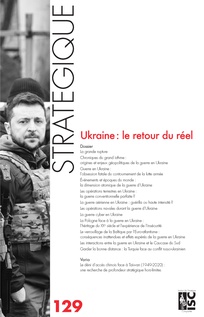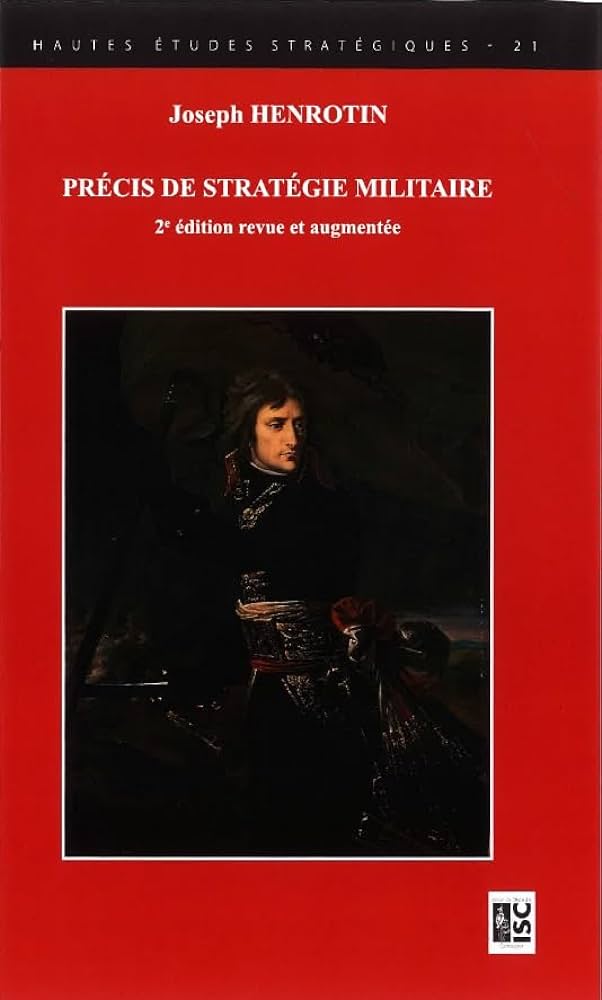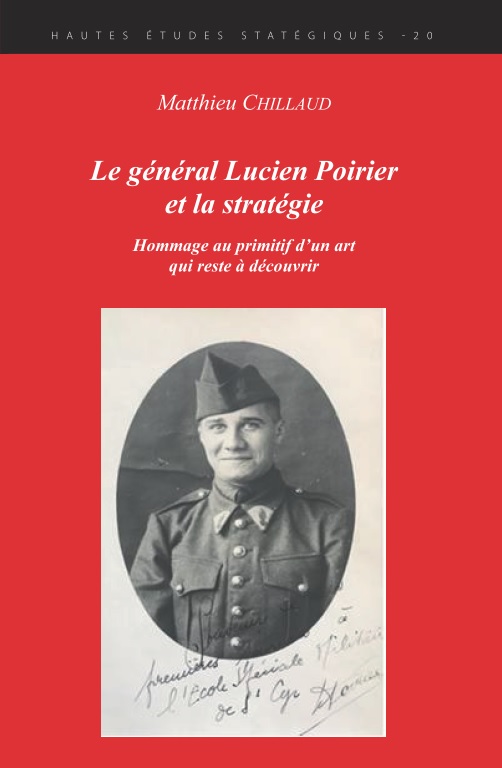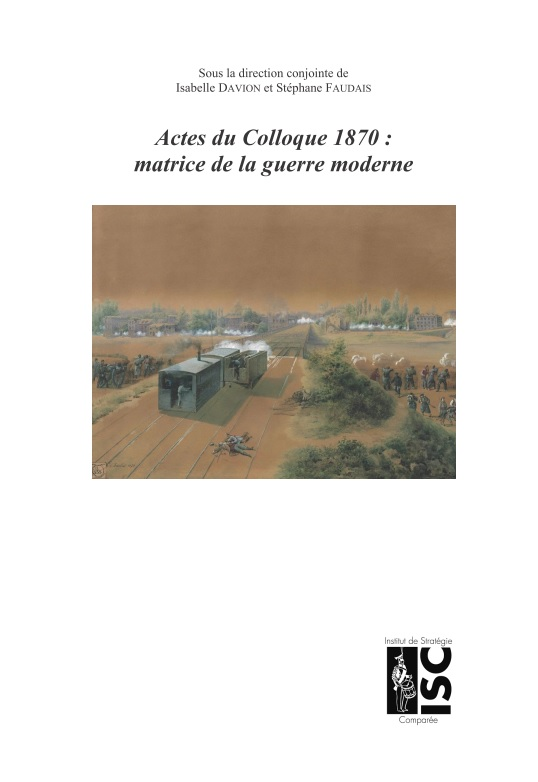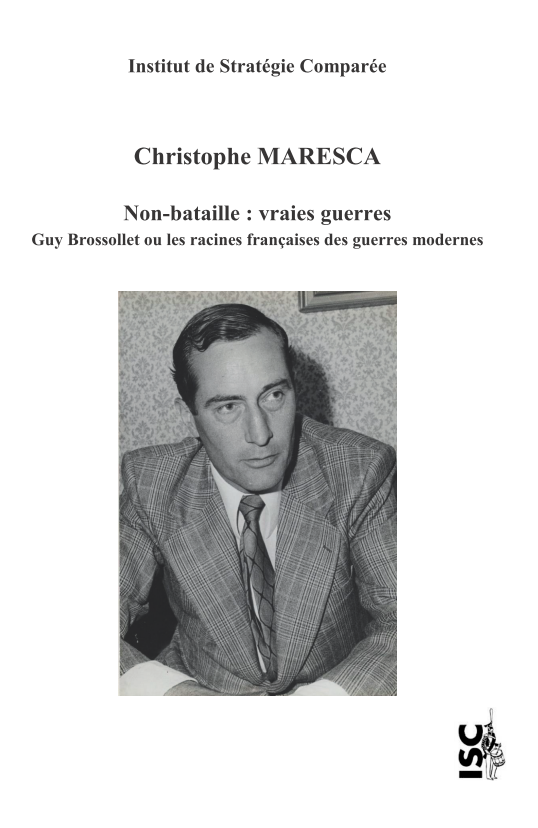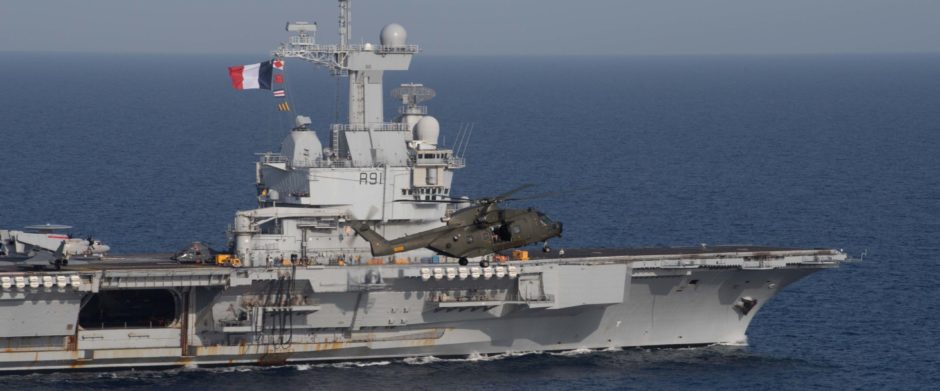I) Généralités
- Ackerman Nordal, On the Doctrine of Limited War, Lund, Lund University Press, 1976.
- Allison Graham T., Explaining a Decision : The Cuban Missile Crisis, Boston, Little Brown, 1971, 2e éd. Avec Philip Zelikov New York, Reading Longman, 1998 (ce livre est vite devenu un classique et continue de susciter le débat : cf. Allyn Bruce, Bright James G. et Welch David A., “Essence of Revision, Moscow, Havana and the Cuban Missile Crisis”, International Security, hiver 1989-1990).
- Annual Defense Department Report (c’est dans ce document que l’on trouve chaque année l’exposé officiel de la stratégie américaine).
- Armacost Michael L., The Politics of Weapons Innovation : The Thor-Jupiter Controversy, New York-Londres, Columbia University Press, 1969.
- Aron Raymond, “Stratégie et dissuasion”, Défense nationale, janvier 1973.
- Ball Desmond, Can Nuclear War Be Controlled ?, Adelphi Papers, 169, automne 1981.
- Ball Desmond et Richelson Jeffrey (eds), Strategic Nuclear Targeting, Ithaca-Londres, Cornell University Press, Cornell Studies in Security Affairs, 1986.
- Betts Richard K. (ed.), Cruise Missiles. Technology, Strategy, Politics, Washington, Brookings, 1981.
- Betts Richard K., Nuclear Blackmail and Nuclear Balance, Washington, Brookings, 1987.
- Blair Bruce G., Strategic Command and Control : Redefining the Nuclear Threat, Washington, Brookings, 1985.
- Blair Bruce G., The Logic of Accidental Nuclear War, Washington, Brookings, 1993.
- Blair Bruce G., Global Zero Alert for Nuclear Forces, Washington, Brookings, 1995.
- Bracken Paul, The Command and Control of Nuclear Forces, New Haven-Londres, Yale University Press, 1983.
- Brodie Bernard (ed.), The Absolute Weapon. Atomic Power and World Order, New York, Harcourt Brace, 1946.
- Brodie Bernard, Escalation and the Nuclear Option, Princeton, Princeton University Press, 1966.
- Chassin L.M. (général), Stratégie et bombe atomique, Paris, Lavauzelle, 1948.
- Cimbala Stephen J., The Past and Future of Nuclear Deterrence, New York, Praeger, 1998.
- Cimbala Stephen J., The New Nuclear Disorder. Challenges to Deterrence and Strategy, Ashgate, Farnham, 2015.
- Coakley Thomas P., Command and Control for War and Peace, Washington, National Defense University Press, 1992.
- David Charles-Philippe, Debating Counterforce. A Conventional Approach in the Nuclear Age, Boulder-Londres, Westview Special Studies in Military Affairs, 1987.
- Delpech Thérèse, Nuclear Deterrence in the 21st Century. Lessons from the Cold War for a New Era of Strategic Piracy, RAND Corp., Santa Monica, 2012.
- Dingman Roger, “Atomic Diplomacy During the Korean War”, International Security, hiver 1988-1989.
- Fehér Ferenc, Heller Agnes, Doomsday or Deterrence? On the Antinuclear Issue, Routledge, London, 2016.
- Freedman Lawrence, The Evolution of Nuclear Strategy, Londres, Macmillan, 1981 (la synthèse la plus sûre, régulièrement remise à jour).
- Garcin Thierry, L’Avenir de l’arme nucléaire, Paris-Bruxelles, LGDJ-Bruylant, 1995.
- Garvey Gerald, Strategy and the Defense Dilemma. Nuclear Policies and Alliance Politics, Lexington-Toronto, Lexington Books, 1984.
- Gavin Francis J., Nuclear Statecraft: History and Strategy in America’s Atomic Age, Georgetown University Press, 2015.
- George Alexander L., Avoiding War, Boulder, Westview, 1992.
- Glaser Charles L., Analyzing Strategic Nuclear Policy, Princeton, Princeton University Press, 1990.
- Gray Colin S., “Nuclear Strategy : The Case for a Theory of Victory”, International Security, été 1979.
- Gray Colin S., “Under Nuclear Gun : Victory Is Possible”, Foreign Policy, 39, été 1980.
- Gray Colin S., Strategic Studies. A Critical Assessment, Londres, Aldwych Press, 1982.
- Gray Colin S., Nuclear Strategy and National Style, Lanham, Hamilton Press-Abt Books, 1986.
- Gray Colin S., Maintaining Effective Deterrence, US Army War College : Carlisle Barracks, August 2003.
- Green Jonathon, The A-Z Nuclear Jargon, Routledge, Londres, 1986.
- Halperin Morton, Limited War in the Nuclear Age, New York, Wiley, 1963.
- Harknett Richard J., “Information Warfare and Deterrence”, Parameters, automne 1996.
- Heuser Beatrice, NATO, Britain, France and the FRG : Nuclear Strategies and Forces for Europe 1949-2000, New York, St Martin’s Press, 1997.
- Heuser Béatrice, Nuclear Mentalities ? Strategies and Belief Systems in Britain, France and the FRG, Londres, Macmillan, 1998.
- Heuser Béatrice, The Bomb: Nuclear Weapons in their Historical, Strategic and Ethical Context, Routledge, London, 2014,
- Hoffmann Stanley, “Terreur et terrier”, Revue française de science politique, décembre 1961.
- Holloway David et Nuti Leopold (Eds.), The Making of the Global Nuclear Order in the 1970s. Issues and Controversies, Routledge, Londres, 2020.
- Holst Johan J. et Nerlich Uwe (eds), Beyond Nuclear Deterrence, Londres, Macdonald & Jane’s, 1977.
- Jervis Robert, Lebow Richard Ned et Stein Janice Gross, Psychology and Deterrence, Baltimore-Londres, The Johns Hopkins Press, 1985 (ne se limite pas à la dissuasion nucléaire).
- Jervis Robert, The Meaning of the Nuclear Revolution : Statecraft and the Prospect of Armageddon, Ithaca-Londres, Cornell University Press, 1989.
- Kahn Herman, On Thermonuclear War, Princeton, Princeton University Press, 1960.
- Kahn Herman, De l’e Métaphores et scénarios, Paris, Calmann-Lévy, Liberté de l’esprit, 1966.
- Kissinger Henry, Nuclear Weapons and Foreign Policy, New York, Harper, 1957.
- Knorr Klaus et Read Thorston (eds), Limited Strategic War, Londres, Pall Mall Press, 1962.
- La Gorce Paul-Marie de, La Guerre et l’atome, Paris, Plon, 1985.
- Lowther Adam B. (ed.), Deterrence: Rising Powers, Rogue Regimes and Terrorism in the Twenty-First Century, Palgrave McMillan, London, 2012.
- Ludvik Jan, Nuclear Asymmetry and Deterrence. Theory, Policy and History, Routledge, London, 2016.
- Mandelbaum, The Nuclear Revolution. International Politics before and after Hiroshima, Cambridge, Cambridge University Press, 1981.
- Manwaring Max G., Deterrence in the 21st Century, Londres-Portland, Frank Cass, 2001.
- Mazarr Michael J. (ed.), Nuclear Weapons in a Transformed World: The Challenge of Virtual Nuclear Arsenals, St. Martin’s Press, New York, 1997.
- Miksche Ferdinand-Otto, Tactique de la guerre atomique, Paris, Payot, 1955.
- Miksche Ferdinand-Otto, La Faillite de la stratégie atomique. Retour aux tranchées ?, Paris, Le livre contemporain, 1958.
- Morgan Patrick M., Deterrence Now, University Press, Cambridge, 2003.
- Morgenthau Hans J., “The Four Paradoxes of Nuclear Strategy”, The American Political Science Review, janvier 1964.
- Nye Jr Joseph S., Allison Graham T. et Carnesale Albert (eds), Fateful Visions. Avoiding Nuclear Catastrophe, cambridge, Ballinger, 1988.
- Osgood Robert E., Limited War Revisited, Boulder, Westview Press, 1978.
- Overy R.J., “Air Power and the Origins of Deterrence Theory before 1939”, The Journal of Strategic Studies, mars 1992.
- Panofsky Erwin, “The Mutual Hostage Relationship between United States and Russia”, Foreign Affairs, décembre 1973.
- Paul T.V., The Tradition of Non-Use of Nuclear Weapons, Stanford University Press, Stanford, 2009.
- Paul T. V., Morgan Patrick M. and Wirtz James J. (Ed.), Complex Deterrence: Strategy in the Global Age, University of Chicago Press, Chicago, 2009.
- Payne Keith B., Schlesinger James, Minimum Deterrence: Examining the Evidence, Routledge, London, 2014.
- Payne Keith B. (Ed.), Understanding Deterrence, Routledge, London, 2015.
- Poirier Lucien, Des stratégies nucléaires, Paris, Hachette, 1977.
- Posen Barry R., Inadvertent Escalation, Ithaca-Londres, Cornell University Press, 1991.
- Roche Nicolas, Pourquoi la dissuasion, PUF, Paris, 2017.
- Rhodes Richard, Arsenals of Folly: The Making of the Nuclear Arms Race, Simon & Schuster Ltd, London, 2008.
- Rosecrance Richard, Strategic Deterrence Reconsidered, Adelphi Papers, 11, printemps 1975.
- Rougeron Camille, La Guerre nucléaire, Paris, Calmann-Lévy, 1962.
- Sagan Scott D., Moving Targets. Nuclear Strategy and National Security, Princeton, Princeton University Press, 1989.
- Sauer Frank, Atomic Anxiety: Deterrence, Taboo and the Non-Use of US Nuclear Weapons, Palgrave McMillan, 2015.
- Schelling Thomas C., “The Waning of Deterrence”, Perspectives in Defense Management, automne 1973.
- Schelling Thomas C., Stratégie du conflit, Paris, Presses universitaires de France, 1980.
- Schelling Thomas C., Arms and Influence, New Haven, Yale University Press, 1966.
- Shaheen Salma, Nuclear Command and Control Norms. A Comparative Study, London, Routledge, 2018.
- Smoke Richard, Controlling Escalation, Cambridge, Harvard University Press, 1977.
- Snyder G., Deterrence and Defense : Toward a Theory of National Security, Princeton, Princeton University Press, 1961.
- Stromseth Jane E., the Origins of Flexible Response : NATO’s Debate over Strategy in the 1960’s, Londres, Macmillan Press, 1988.
- Tertrais Bruno, L’Arme nucléaire après la guerre froide. L’Alliance atlantique, l’Europe et l’avenir de la dissuasion, Paris, Crest-Économica, 1994.
- Tertrais Bruno, L’Arme nucléaire, Paris, Presses universitaires de France, Que sais-je ?, 3798, 2010.
- Thakur Ramesh, Nuclear Weapons and International Security. Collected Essays, Routledge, London, 2016.
- Vandier Pierre, La dissuasion au troisième âge nucléaire, Editions du Rocher, Paris, 2018.
- Warren Aiden et Philip M. Baxter (Ed.), Nuclear Modernization in the 21st Century, Routledge, Londres, 2020.
- X-Défense, La Paix nucléaire en question, Paris, FEDN, Les Sept Épées 45, 1989.
- Zimm Alan D., “Deterrence : Basic Theory, Principles and Implications”, Strategic Review, printemps 1997.
II) Stratégie nucléaire américaine
- Albertson Trevor, Winning Armageddon. Curtis LeMay and Strategic Air Command, 1948–1957, Naval Institute Press, Annapolis, 2019.
- Armacost Michael H., The Politics of Weapons Innovation : The Thor-Jupiter Controversy, New York, Columbia University Press, 1969.
- Ayson Robert, Thomas Schelling and the Nuclear Age. Strategy as a Social Science, Londres-Portland, Frank Cass, 2004.
- Bacevich A.J., The Pentomic Era : the U.S. Army between Korea and Vietnam, Washington, National Defense University Press, 1986.
- Ball Desmond, Politics and Force Levels. The Strategic Missile Program of the Kennedy Administration, Berkeley-Londres, University of California Press, 1980.
- Ball Desmond et Toth Robert C., “Revising the SIOP : Taking War-Fighting to Dangerous Extrêmes”, International Security, 14-4, printemps 1990.
- Beard Edmud, Developing the ICBM. A Study in Bureaucratic Politics, New York, Columbia University Press, 1976.
- Bentley Michelle, Weapons of Mass Destruction and US Foreign Policy. The Strategic Use of a Concept Londres, 2014.
- Bobbitt Philip, Freedman Lawrence et Treverton Gregory F., US Nuclear Strategy : A Reader, Londres, Macmillan Press, 1989.
- Boyer Paul, By the Bomb’s Early Light : American Thought and Culture at the Dawn of the Atomic Age, New York, Pantheon Books, 1985.
- Brodie Bernard (dir.), La Guerre nucléaire. Quatorze essais sur la nouvelle stratégie américaine, Paris, Stock, 1965.
- Brown Anthony Cave (ed.), Operation World War III. The Secret American Plan “Dropshot” for War with the soviet Union, Londres, Arms & Armour Press, 1979.
- Cannon Michael W., ”The Development of the American Theory of Limited War 1945-1963”, Armed Forces and Society, automne 1992.
- Charlton Michael, From Deterrence to Defense : The Inside Story of Strategic Policy, Cambridge, Harvard University Press, 1987.
- Dalgleich D. Douglas et Schweikart Larry, Trident, Carbondale-Edwardsville, Southern Illinois University Press, 1984.
- Davis Lynn E., Limited Nuclear Options. Deterrence and the New American Doctrine, Adelphi Papers, 121, hiver 1975-1976.
- Enthoven Alain C. et Smith K. Wayne, How Much Is Enough ? Shaping the Defense Program, 1961-1969, New York, Harper & Row, 1971.
- Ford Daniel, The Button : The Pentagon’s Strategic command and Control System, New York, Simon & Schuster, 1985.
- Gallagher carole, American Ground Zero : The Secret Nuclear War, Cambridge, MIT Press, 1993.
- Garthoff Raymond L., The Great Transition : American-Soviet Relations and the End of the Cold War, Washington, Brookings, 1994.
- George Alexander L. et Smoke Richard, Deterrence in American Foreign Policy : Theory and Practice, New York, Columbia University Press, 1974.
- Ghamari-Tabrizi Sharon, The Worlds of Herman Kahn: The Intuitive Science of Thermonuclear War, Harvard University Press, Cambridge, 2005.
- Gioe David, Scott Len, Andrew Christopher (eds.), An International History of the Cuban Missile Crisis. A 50-year retrospective, Routledge, London, 2015.
- Gray Colin S., Strategic Studies and Public Policy. The American Experience, Lexington, The University Press of Kentucky, 1982.
- Greenwood Ted, Making the MIRV : A Study of Defense Decision Making, Cambridge, Ballinger, 1975.
- Hopkins J.C. et Goldberg Sheldon A., The Development of Strategic Air Command, 1946-1986, Offritt Air Force Base, Office of the Historian, Strategic Air Command, 1986.
- Howard Michael, “Brodie, Wohlsletter and American Nuclear Strategy”, Survival, 34-2.
- Huntington Samuel R., The Common Defense : Strategic Programs in National Politics, New York, Columbia University Press, 1961.
- Jervis Robert, The Illogic of American Nuclear Strategy, Ithaca-Londres, Cornell University Press, 1984.
- Kaplan Edward, To Kill Nations. American Strategy in the Air Atomic Age and the Rise of Mutually Assured Destruction, Cornell University Press, Ithaca, 2015.
- Kaufmann William W., The McNamara Strategy, New York-Londres, Harper & Row, 1964.
- Kroenig Matthew, The Logic of American Nuclear Strategy. Why Strategic Superiority Matters, Oxford, Oxford University Press, 2018.
- Maddock Shane J., Nuclear Apartheid: The Quest for American Atomic Supremacy From World War II to the Present, Chapel Hill : University of North Carolina Press, 2010.
- Meilinger Philip S., Bomber. The Formation and Early Years of Strategic Air Command, Air University Press, Maxwell, 2012.
- Moody Walton S., Building a Strategic Air Force, Washington, Air Force History & Museums Program, 1996.
- Nash Philip, The Other Missiles of October : Eisenhower, Kennedy, and the Jupiters, 1957-1963, Durham, University of North Carolina Press, 1997.
- Young Ken, Warner R. Schilling, Super Bomb: Organizational Conflict and the Development of the Hydrogen Bomb, Cornell University Press, Ithaca, 2020.
- Pomeroy Steven A., An Untaken Road. Strategy, Technology, and the Hidden History of America’s Mobile ICBMs, Annapolis, Naval Institute Press, 2016.
- Rhodes Richard, The Making of the Atomic Bomb, New York, Simon & Schuster, 1986.
- Rhodes Richard, Dark Sun : The Making of the Hydrogen Bomb, New York, Simon & Schuster, 1995.
- Ritchie Nick, US Nuclear Weapons Policy After the Cold War. Russians, ‘Rogues’ and Domestic Division, Routledge, London, 2015.
- Rose John P., The Evolution of US Army Nuclear Doctrine, 1945-1980, Boulder, Westview, 1980.
- Rosenberg David Alan, “The Origins of Overkill. Nuclear Weapons and American Strategy 1945-1960”, International Security, VII-4, printemps 1983 (capital).
- Rosenberg David Alan, “American Atomic Strategy and the Hydrogen Bomb Decision”, Journal of American History, 61, juin 1979.
- Sagan Scott D., “SIOP-62 : The Nuclear Plan Briefing to President Kennedy”, International Security, 12-1, 1987.
- Schelling Thomas C., “Les Armements nucléaires, l’OTAN et la nouvelle stratégie”, Politique étrangère, été 1963.
- Schwartz Stephen I., Atomic Audit. The Costs and Consequences of U.S. Nuclear Weapons since 1940, Washington, Brookings, 1998 (très neuf).
- Steiner Barry H., Bernard Brodie and the Foundations of American Nuclear Strategy, Lawrence, University Press of Kansas, 1991.
- Wohlstetter Albert, “The Delicate Balance of Terror”, Foreign Affairs, janvier 1959.
III) Stratégie nucléaire française
- Ailleret Charles, L’Aventure atomique française : souvenirs et réflexions, Paris, Grasset, 1968.
- Aron Raymond, Le Grand débat, Paris, Calmann-Lévy, 1963.
- Beaufre André (général), Dissuasion et stratégie, Paris, Armand Colin, 1964.
- Bernstein Barton J., “Eclipsed by Hiroshima and Nagasaki”, International Security, 15-4, 1991.
- Bru Alain et Poirier Lucien, “Dissuasion et défense anti-missiles II”, Revue de Défense nationale, novembre 1968.
- Caron François, “Le concept français de dissuasion”, conférence à l’ESGI, 1987.
- Duval Marcel et Le Baut Yves, L’Arme nucléaire française : pourquoi et comment ?, Paris, S.P.M., 1992.
- Duval Marcel et Mongin Dominique, Histoire des forces nucléaires françaises depuis 1945, Paris, Presses universitaires de France, Que sais-je ? 2822, 1993.
- Gadal Serge, Force aériennes stratégiques, Coll. « Bibliothèque stratégique », Economica, Paris, 2009.
- Gallois Pierre-Marie (général), Stratégie de l’âge nucléaire, Paris, Calmann-Lévy, 1960.
- Guisnel Jean et Tertrais Bruno, Le président et la bombe. Jupiter à l’Elysée, Paris, Odile Jacob, 2016.
- Mongin Dominique, La Bombe atomique française 1945-1958, Paris-Bruxelles, LGDJ-Bruylant, 1997.
- Pascallon Pierre (dir.), Quel avenir pour la dissuasion nucléaire française face aux défis des changements géostratégiques d’aujourd’hui et de demain ?, Coll. « Défense », L’Harmattan, Paris, 2015.
- Valensi Edouard, La dissuasion nucléaire. L’aventure nucléaire française, L’Harmattan, Paris, 2013.
- Jacques Villain, La force nucléaire française. L’aide des Etats-Unis, « Hautes Etudes Militaires », Economica, Paris, 2014.
- Theleri Marc, Initiation à la force de frappe française 1945-2010, Paris, stock, 1997 (documentation étonnante).
IV) Stratégie nucléaire britannique
- Baylis John, Ambiguity and Deterrence : British Nuclear Strategy, 1945-1964, oxford, Oxford University Press, 1995.
- Booth Ken et Baylis John, Britain, NATO and Nuclear Weapons, Londres, Macmillan, 1989.
- Clark Ian, Nuclear Diplomacy and the Special Relationship : Britain’s Deterrent and America, 1957-1962, Oxford, The Clarendon Press, 1994.
- Grennberg Myron A., Physics and Metaphysics of Deterrence. The British Approach, Newport, Naval War College, Newport Papers 8, 1994.
- Gowing Margaret, Independence and Deterrence, Londres, Macmillan, 2 vol., 1974.
- Groom John, British Thinking about Nuclear Weapons, Londres, Frances Pinter, 1974.
- Freedman Lawrence, Britain and Nuclear Weapons, Londres, Macmillan, 1980 (à compléter par son article “Britain : the First Ex-Nuclear Power ?”, International Security, automne 1981).
- Jones Matthew, The Official History of the UK Strategic Nuclear Deterrent. Volume I: From the V-Bomber Era to the Arrival of Polaris, 1945-1964, Routledge, London, 2017.
- Jones Matthew, The Official History of the UK Strategic Nuclear Deterrent. Volume II: The Labour Government and the Polaris Programme, 1964-1970, Routledge, London, 2017.
- Menaul Stewart, Britain’s Strategic Nuclear Forces, Londres, Robert Hale, 1980.
- Paterson Robert H., Britain’s Strategic Nuclear Deterrent, Londres-Portland, Frank Cass, 1997.
- Pierre Andrew, Nuclear Politics. The British Experience with an Independent Strategic Force 1939-1970, Oxford-Londres, Oxford University Press, 1970.
- Rosecrance Richard, Defense of the Realm, British Strategy in the Nuclear Epoch, New York-Londres, Columbia University Press, 1968.
V) Stratégie nucléaire russe
- Bluth Christoph, Soviet Strategic Arms policy before SALT, Cambridge, Cambridge University Press, 1992.
- Douglass Jr Joseph D. et Hober Amoretta M., Soviet Strategy for Nuclear War, Stanford, Hoover Institution Press, 1979.
- Garthoff Raymond L., Soviet Strategy in the Nuclear Age, New York, Praeger, 1962.
- Garthoff Raymond L., “Mutual Deterrence and Strategic Arms Limitation in Soviet Policy”, International Security, 1978-1 (cf. la lettre réponse de Donald Brennan, International Security, 1978-3).
- Garthoff Raymond L., Deterrence and the Revolution in Soviet Military Doctrine, Washington, Brookings, 1990.
- Holloway David, The Soviet Union and the Arms Race, New Haven-Londres, Yale University Press, 1983.
- Holloway David, Stalin and the Bomb : The Soviet Union and Atomic Energy, 1939-1956, New Haven, Londres, Yale University Press, 1994.
- Horelick Arnold et Rush Myron, Strategic Power and Soviet Foreign Policy, chicago-Londres, University of Chicago Press, 1965.
- Laird Robin F. et Hersping Dale R., The Soviet Union and Strategic Arms, Boulder-Londres, Westview Press, 1984.
- Miller Mark E., Soviet Strategic Power and Doctrine : The Quest for Superiority, Coral Gables, Advanced International Studies Institute, 1982.
- Payne Jr Samuel B., The Soviet Union and SALT, Cambridge-Londres, The MIT Press, 1980.
- Paris Henri (général), L’Atome rouge : le nucléaire soviétique et russe, Paris, L’Harmattan, 1996.
- Romer Jean-Christophe, La Guerre nucléaire de Staline à Krouchtchev, Paris, Publications de la Sorbonne, 1991.
- Tritten James J., Soviet Naval Forces and Nuclear Warfare. Weapons, Employment and Policy, Boulder-Londres, Westview, 1986.
VI) Stratégie nucléaire chinoise
- Chen Shihmin, “La conception chinoise de la dissuasion à l’époque de Mao Zedong”, Stratégique, 63, 1996-3.
- Chen Shihmin, “L’évolution de la conception chinoise de la dissuasion nucléaire depuis l’époque de Deng Xiaoping (après 1978)”, Stratégique, 70‑71, 1998-2/3.
- Lewis Jeffrey G. (Ed.), Paper Tigers. China’s Nuclear Posture, Routledge, London, 2014.
- Lewis John Wilson et Xue Litai, China Builds the Bomb, Stanford, Stanford University Press, 1988.
- Lewis John Wilson et Xue Litai, China’s Strategic Seapower. the Politics of Force Modernization in the Nuclear Age, Stanford, Stanford University Press, 1994.
- Lewis John Wilson et Hua Di, “China’s Ballistic Missile Programs. Technologies, Strategies, Goals”, International Security, automne 1992.
- Shu Guang Zhang, Deterrence and Strategic Culture : Chinese-American Confrontations, Ithaca-Londres, Cornell University Press, 1992.
VII) Dissuasion conventionnelle
- Boyd-Carpenter Thomas, Conventional Deterrence into the 1990s, Palgrave MacMillan, Londres, 1989.
- Filippidou, Anastasia (Ed.), Deterrence. Concepts and Approaches for Current and Emerging Threats, Springer, Londres, 2020.
- Golden James (ed.), Conventional Deterrence, Lexington, Heath, 1984.
- Harknett Richard J., “The Logic of Conventional Deterrence at the end of the Cold War”, Security Studies, 4-1, 1994.
- Huntington Samuel P., “Conventional Deterrence and Conventional Retaliation in Europe”, International Security, hiver 1983-1984.
- Killebrew Robert, Conventional Defense and Total Deterrence, Delaware, Scholarly Ressources, 1986.
- Mearsheimer John J., Conventional Deterrence, Ithaca-Londres, Cornell University Press, 1983.
- Shimshoni Jonathan, Israel and Conventional Deterrence, Border Warfare from 1953 to 1970, Ithaca-Londres, Cornell University Press, 1988.
- Wirtz James J., “Strategic Conventional Deterrence. Lessons from the Maritime Strategy”, Security Studies, 3-1, automne 1993.
- Yaniv Avner, Deterrence without the Bomb. The Politics of Israel Strategy, Lexington, Lexington Books, 1993.
VIII) Défense stratégique
- Baulon Jean-Philippe, “La National Missile Defense en débat”, Stratégique, 77, 2000-1.
- Baulon Jean-Philippe, Défense contre les missiles balistiques. Depuis 1945, Paris, ISC-Économica, Bibliothèque stratégique, 2006.
- Baulon Jean-Philippe, L’Amérique vulnérable ? Antimissiles, Paris, ISC-Économica, Bibliothèque stratégique, 2009.
- Bruce-Briggs B., The Shield of Faith : A Chronicle of Strategic Defense from Zeppelins to Star Wars, New York, Simon & Schuster, 1988.
- Chayes Abram et Wiesner Jerome B., An Evaluation of the Decision to Deploy an Antiballistic Missile System, New York, Signet Books, 1969.
- Daniel Donald C., Anti-Submarine Warfare and Superpower Strategic Stability, Houndmills-Londres, Macmillan, Studies in International Security 24, 1986.
- La Défense anti-missiles balistiques, Paris, Cahiers de la Fondation pour les Études de Défense, hors-série 4, 1998.
- Delorme Emmanuel, Gruselle Bruno, Schlumberger Guillaume, La nouvelle guerre des étoiles. Idées reçues sur la défense antimissile, Le Cavalier Bleu, Paris, 2013.
- Elleman Michael et Dodge Toby, Missile-Defence Cooperation in the Gulf, Routledge, London, 2016.
- Futter Andrew, Ballistic Missile Defence and US National Security Policy. Normalisation and Acceptance after the Cold War, Routledge, London, 2015.
- Mathers Jennifer G., “« A Fly in Outer Space » : Soviet Ballistic Missile Defence during the Khruschev Period”, The Journal of Strategic Studies, 21-2, juin 1998.
- Mayer Michael, US Missile Defense Strategy. Engaging the Debate, Lynne Rienner, Londres, 2014.
- Payne Keith B., Missile Defense in the 21st Protection Against Limited Threats, Including Lessons from the Gulf War, Boulder-San Francisco-Londres, Westview, 1991.
- Sauer Tom, Eliminating Nuclear Weapons. The Role of Missile Defence, Londres, Hurst, 2011.
- Schaffel Kenneth, The Emerging Shield : The Air Force and the Evolution of Continental Air Defense, 1945-1960, Washington, Office of Air Force History, 1991.
- Stefanick Tom, Strategic Antisubmarine Warfare and Naval Strategy, Lexington, Lexington Books, 1987.
IX) Prolifération
- Abbas Hassan, Pakistan’s Nuclear Bomb: A Story of Defiance, Deterrence and Deviance, Londres, Hurst, 2018.
- Abbasi Rizwana et Zafar Khan, Nuclear Deterrence in South Asia. New Technologies and Challenges to Sustainable Peace, Routledge, Londres, 2019.
- Allison Graham T. et al., Avoiding Nuclear Anarchy : Containing the Threat of Loose Russian Nuclear Weapons and Fissile Material, Cambridge, The MIT Press, 1996.
- Bailey Kathleen C., Strenghtening Nuclear Non-Proliferation, Boulder-San Francisco-Londres, Westview, 1993.
- Beaton Leonard et Maddox John, The Spread of Nuclear Weapons, Londres, Chatto & Windus, 1962.
- Cigar Norman, Saudi Arabia and Nuclear Weapons. How do countries think about the bomb?, Routledge, London, 2016.
- Dokos Thanos P., Countering the Proliferation of Weapons of Mass Destruction. NATO and EU Options in the Mediterranean and the Middle East, Routledge, London, 2014.
- Duval Marcel, “De la non-prolifération à la contre-prolifération ?”, défense nationale, août-septembre 1995.
- Duval Marcel, “L’arme nucléaire dans le monde. État des lieux”, Défense nationale, janvier 1998.
- Duval Marcel, “à la recherche d’un secret : l’arme nucléaire israélienne”, Défense nationale, avril 1998.
- Feldman Shai, Israeli Nuclear Deterrence, New York, Columbia University Press, 1982.
- Fitzpatrick Mark, Overcoming Pakistan’s Nuclear Dangers, Routledge, Londres, 2014.
- Fitzpatrick Mark, Asia‘s Latent Nuclear Powers. Japan, South Korea and Taiwan, Routledge, London, 2016.
- Foran Virginia,S. Nuclear Non-Proliferation Policy, 1945-1991, Alexandria, Chadwyck-Healey, 1992.
- Géré François, La Prolifération nucléaire, Paris, Presses universitaires de France, Que sais-je ?, 1996.
- Hagerty, Devin T., Nuclear Weapons and Deterrence Stability in South Asia, Springer, Londres, 2020.
- Karl David, “Proliferation Pessimism and Emerging Nuclear Powers”, International Security, hiver 1996-1997.
- Kamrava Mehran, The Nuclear Question in the Middle East, Londres, Hurst, 2012.
- Khan Zafar, Pakistan‘s Nuclear Policy. A Minimum Credible Deterrence, Routledge, London, 2014.
- Labbé Marie-Hélène, La Prolifération nucléaire en 50 questions, Paris, Jacques Bertoin, 1992.
- Labbé Marie-Hélène, La Tentation nucléaire, Paris, Payot, 1995.
- Lanoszka Alexander, Atomic Assurance: The Alliance Politics of Nuclear Proliferation, Cornell University Press, Ithaca, 2018.
- Legault Albert et Fortmann Michel (dir.), Prolifération et non-prolifération nucléai Stratégies et contrôles, Québec-Paris, Centre québecois de relations internationales-Fondation pour les études de défense nationale, 1993.
- Maddox John, Prospects for Nuclear Proliferation, Adelphi Papers, 113, 1975.
- O’Reilly Kelly, Nuclear Proliferation and the Psychology of Political Leadership. Beliefs, Motivations and Perceptions, Routledge, London, 2016.
- Panda Ankit, Kim Jong Un and the Bomb. Survival and Deterrence in North Korea, London, Hurst, 2020.
- Pant Harsh V. (ed.), Handbook of Nuclear Proliferation, Routledge, London, 2015.
- Prolifération et non-prolifération nucléaires. Les enjeux de la conférence de 1995 sur l’extension du T.N.P., Paris, Fondation pour les études de défense, Perspectives stratégiques 1, s.d.
- Quester George H., The Politics of Nuclear Proliferation, Baltimore, The Johns Hopkins University Press, 1973.
- Rajagopalan Rajesh et Mishra Atul, Nuclear South Asia. Keywords and Concepts, Routledge, New Delhi, 2014.
- Sagan Scott, “Why Do States Build Nuclear Weapons ?”, International Security, hiver 1996-1997.
- Sagan Scott D. and Waltz Kenneth N., The Spread of Nuclear Weapons: An Enduring Debate, W.W. Norton, New York, 2012.
- Subrahmanyam K. (ed.), India and the Nuclear Challenge, New Delhi, Lancer, 1986.
- Tertrais Bruno, Le marché noir de la bombe. Enquête sur la prolifération nucléaire, Buchet Chastel, Paris, 2009.
- Waltz Kenneth N., The Spread of Nuclear Weapons : More May Be Better, Adelphi Papers, 171, 1981.
X) Armements chimiques et biologiques
- Balmer B., Britain and Biological Warfare. Expert Advice and Science Policy, 1930-65, Springer, Londres, 2001.
- Banoub, Joseph (Ed.), Detection of Biological Agents for the Prevention of Bioterrorism, Springer, Londres, 2011.
- Coleman, K., A History of Chemical Warfare, Palgrave MacMillan, Londres, 2005.
- Croddy Éric, Chemical and Biological Warfare. An Annotated Bibliography, lanham, Scarecrow Press, 1997.
- Croddy, Eric, Chemical and Biological Warfare. A Comprehensive Survey for the Concerned Citizen, Springer, Londres, 2002.
- Dando, Malcolm R., Preventing Biological Warfare. The Failure of American Leadership, Palgrave McMillan, Springer, Londres, 2002.
- Falkensath Richard A., Newman Robert D. et Thayer Bradley A., America’s Achille’s Heel. Nuclear, Biological and Chemical Terrorism and Covert Attack, Cambridge-Londres, The MIT Press, 1998.
- Fong, I.W., Alibek, Kenneth (Eds.), Bioterrorism and Infectious Agents. A New Dilemma for the 21st Century, Springer, Londres, 2009.
- Giannakoudakis Dimitrios A., Bandosz, Teresa J., Detoxification of Chemical Warfare Agents. From WWI to Multifunctional Nanocomposite Approaches, Springer, Londres, 2018.
- Hammond, P., Carter Gradon, From Biological Warfare to Healthcare. Porton Down, 1940-2000, Palgrave McMillan, Londres, 2001.
- Hoenig, Steven L., Compendium of Chemical Warfare Agents, Springer, Londres, 2007.
- Lepick Olivier, La Grande guerre chimique 1914-1918, Paris, Presses universitaires de France, Histoires, 1998.
- Lindler, Luther E., Lebeda, Frank J., Korch, George (Eds.), Biological Weapons Defense. Infectious Disease and Counterbioterrorism, Springer, Londres, 2005.
- Martellini, Maurizio, Trapp, Ralf (Eds.), 21st Century Prometheus. Managing CBRN Safety and Security Affected by Cutting-Edge Technologies, Springer, Londres, 2020.
- McBride David (Ed.), Bioterrorism: The History of a Crisis in American Society. Epidemics, Bioweapons, and Policy History, Routledge, Londres, 2020.
- Meyer Claude, L’Arme chimique, Paris, FRS-Ellipses, 2001.
- Riche Daniel, Les armes chimiques et biologiques, L’Archipel, Paris, 2011.
- Rimmington Anthony, Stalin’s Secret Weapon. The Origins of Soviet Biological Warfare, Londres, Hurst, 2018.
- Sindona, Giovanni, Banoub, Joseph H., Di Gioia, Maria Luisa (Eds.), Toxic Chemical and Biological Agents. Detection, Diagnosis and Health Concerns, Springer, Londres, 2020.
- Smith Frank L., American Biodefense. How Dangerous Ideas about Biological Weapons Shape National Security, Cornell University Press, Ithaca, 2014.
- Spiers Edward M., Chemical Warfare, Springer, Londres, 1986.
- Spiers, Edward M., Chemical Weaponry. A Continuing Challenge, Palgrave MacMillan, Londres, Springer, Londres, 1989.
- Whitby, S., Biological Warfare Against Crops, Springer, Londres, 2002.
